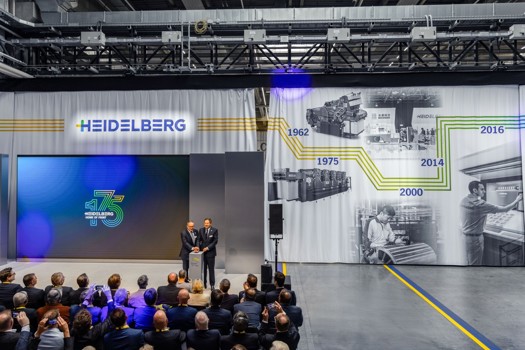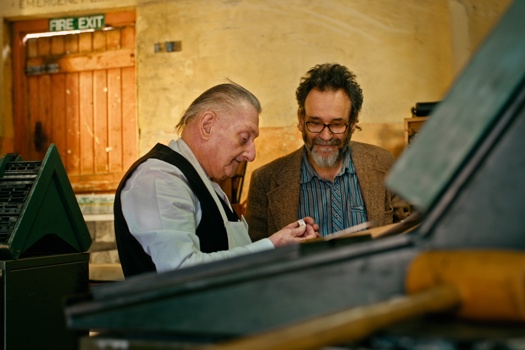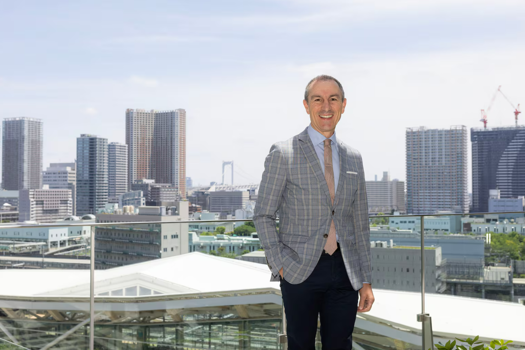The director of Glossop Cartons had already placed an order for a B1 monster machine he had never before seen. It was that very machine at Düsseldorf, and he had just forked out £1.8m.
“The first time we saw the press was on the Drupa floor, and it was a strange, kind of funny experience,” he explains. “Looking at a press at Drupa, knowing it belonged to us, was odd for a company that still sees itself as little old family-run Glossop Cartons. But here we were in Germany surrounded by everyone and their uncle looking at the same major piece of equipment.”
Glossop Cartons is something more than just a “little old family-run” firm. Although Sidebottom and his wife, co-director Jacky Sidebottom, run the business, their 80 staff make £8.25m turnover from supplying millions of cartonboard products to clients such as multiple retailers. So big is this family unit that about two years ago it had to move from its Derbyshire home to a larger HQ in Stockport, Cheshire.
Six months before the Drupa jaunt, Mitsubishi and its UK agent M Partners approached Sidebottom explaining they would show off a new machine at Düsseldorf that June, was he interested? No stranger to the Japanese manufacturer, Glossop Cartons had taken a five-colour version of the RMGT back in 2009. And it was “fantastic” – never broke down; always reliable. “Might be,” he said.
“We knew we needed to change an old press – a KBA 104 with coater – but needed a route to do it. This could be it: we were so impressed with the five-colour machine, there was never any thought of looking elsewhere. The total costs in nine years of running that five-colour press were probably less than those for one single year from any other manufacturer.”
Mutually beneficial
Mitsubishi also saw an opportunity: shipping a hefty, 9m-long piece of kit from the Far East to Germany and back again would be costly. Once in Europe, why not keep it there? The Japanese business targeted its satisfied customer Glossop Cartons, asking it to spec the demo machine to its requirements. Then it dangled a tantalising price offer, and Sidebottom was happy to oblige.
“We had the ability to say what we wanted, so we went for a full packaging spec. We didn’t need its LED UV capability: we use low-migration inks with limited colours and only want conventional UV. We wanted a raised plinth for high loads, full non-stop feeder and delivery and we needed auto oscillation in off mode to tighten colour control.”
His team didn’t even trial the kit: “Print tests are all very well, but there’s nothing between them, and all firms say ‘our kit goes fast’. Mitsubishi is not the quickest, but we are talking minutes, not hours. We do short-run work, so 18,000sph isn’t important. What is important is reliability. Output from Mitsubishi is just as good as the rest and there are no breakdown issues, so in effect it’s better.”
While the old KBA was taken apart and removed over one weekend in June 2016, the Drupa machine was dismantled and crated, ready for shipping from Germany to the UK. Before it arrived in several wagons, however, pre-built stanchions were bolted to the concrete floor at Glossop Cartons so the press would sit on super-secure metal feet.
The RMGT 1050 LX 6 CC LD, which “in English equates to a Mitsubishi B1,six-colour sheetfed press with coater”, quips Sidebottom, took two weeks to install. It would have been quicker, but the LED UV unit had to be replaced on site by its conventional UV alternative. Even so, transforming a stack of crates into a fully functioning 16,200sph B1 press in a fortnight was impressive, he says.
Glossop’s press has inter-deck UV drying, as well as IR and warm air options.
“It helped that we had already specced the machine and they weren’t building it up from new, but I was happy with the speed of delivery.
“Training was also fairly straightforward because the new machine is similar to the five-colour model we bought in 2009. However, that technology is nine years old and this new state-of-the art machine did throw up training issues.
“We needed extra work on simultaneous plate changing, non-stop delivery, software and colour navigation, which were new or different. But after safety training and a few dos and don’ts, learning to operate the kit was not a problem. It was however ‘live training’: we were doing proper print jobs while we learned because we wanted to get going on the new kit as soon as possible.”
The RMGT 1050 works like a conventional press. Punched plates feed into the machine, while cylinders synchronise themselves. Unlike the five-colour kit where each plate takes one and a half minutes to change, the new six-colour model changes all of the plates in the same time with no human intervention. In nearly two years of operation there have been just three failed plate changes.
Closed-loop controls enable operators to transfer data to the ink ducts, which configure themselves to the plate frames – most jobs are four colour with a spot colour sometimes added to the duct. The workflow sends data to the press, while the operator types in the sheet size and configures the feeder and delivery units, from which spool 50 sheets for colour testing.
Screen burn?
While Sidebottom liked what he saw at Drupa. he wasn’t totally convinced by all of the new technology. There was that bumper-size 55in display screen. And were all those cameras really necessary – wasn’t some of the tech just a bit “gimmicky”? Those misgivings however fizzled away when he hit the ‘print’ button at Stockport.
“There are a lot of cameras – on feeder boards, delivery areas and elsewhere – which I had doubts about. But when the machine is in production you can see what is happening at critical points. When you are at the delivery end for example you see what is happening several metres away at the feeder unit. The display screen, cameras and colour navigation work together perfectly.”
He adds: “It’s so much more than just a modernised version of the five-colour machine. It’s much more advanced, giving us historical data, reports on every sheet we’ve scanned and colour-bar data in each ink duct. Auditors tell us the discrepancies are the smallest they have seen, while we have no fear showing customers the kit. If they want to brighten the reds or add magenta it only takes a few key strokes and the client is blown away. Press passing is a pleasure.”
The only “slight problem”was a coater issue, Glossop Cartons uses both water-based and UV coatings. But the technology was reconfigured quickly thanks to WhatsApp – operators send a photo for a super-speedy response from back-up engineers. He also points out the machine is ergonomically tight, perhaps because the Japanese tend to be of slighter build than Europeans, but “that’s me being ridiculously picky”, adds Sidebottom.
“Would I buy another one? Without doubt. It does everything I was told it could do. I don’t know the list price, but we got it at a good discount, and if I could change the five-colour – and had the money – I would do just that.”
SPECIFICATIONS
Max speed 16,200sph
Max sheet size 750x1,050mm
Max printing area 740x1,050mm
Paper thickness 0.05-0.78mm
Feeder stacking capacity 1,110mm
Printing unit configurations Up to eight units
Footprint 9.5x4m
Cost £1.8m discounted price for Glossop Cartons
Contact RMGT www.rmgt.com M Partners (MPL) 020 8835 2221 www.mpartners.co.uk
Company profile
Glossop Cartons is a family firm now based in Stockport. It launched in 1982 in Derbyshire and has become one of the UK’s leading manufacturers of cartonboard packaging products, serving clients including major multiple retailers. In late 2015, it almost doubled the size of its business by acquiring Stockport-based Contact Print & Packaging
Why it was bought…
Glossop Cartons wanted to replace a six-colour KBA 104 with a more up-to-date machine that was robust and reliable, easy to use and served with tried-and-tested back up.
How it has performed…
The machine “does everything I was told it could do”, says director Brian Sidebottom. “If I could clone the machine, I would, and if I could change our existing five-colour RMGT for another six-colour model I would do just that – if I had the money.”










